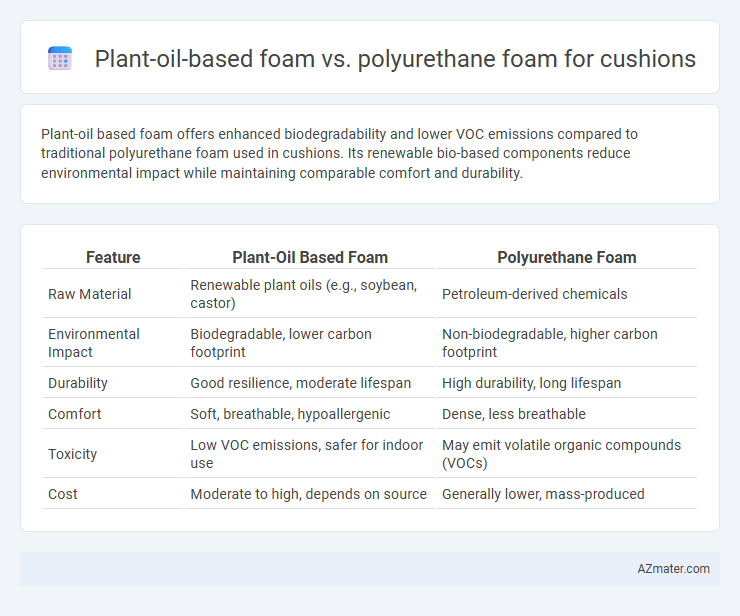Plant-oil based foam offers enhanced biodegradability and lower VOC emissions compared to traditional polyurethane foam used in cushions. Its renewable bio-based components reduce environmental impact while maintaining comparable comfort and durability.
Table of Comparison
| Feature | Plant-Oil Based Foam | Polyurethane Foam |
|---|---|---|
| Raw Material | Renewable plant oils (e.g., soybean, castor) | Petroleum-derived chemicals |
| Environmental Impact | Biodegradable, lower carbon footprint | Non-biodegradable, higher carbon footprint |
| Durability | Good resilience, moderate lifespan | High durability, long lifespan |
| Comfort | Soft, breathable, hypoallergenic | Dense, less breathable |
| Toxicity | Low VOC emissions, safer for indoor use | May emit volatile organic compounds (VOCs) |
| Cost | Moderate to high, depends on source | Generally lower, mass-produced |
Introduction to Cushion Foams
Plant-oil based foam offers a sustainable alternative to traditional polyurethane foam by utilizing renewable resources such as soybean or castor oil, reducing dependence on petroleum-based materials. Cushion foams require properties like resilience, comfort, and durability, where plant-oil foams demonstrate comparable performance with enhanced eco-friendliness and lower carbon footprint. Polyurethane foam remains popular due to its versatility and established manufacturing processes, but increasing environmental concerns drive demand for bio-based cushion materials that balance functionality with sustainability.
What is Plant-Oil Based Foam?
Plant-oil based foam is a sustainable alternative to conventional polyurethane foam, derived from renewable resources such as soy, coconut, or castor oils. It offers similar cushioning properties while reducing environmental impact through lower carbon emissions and biodegradability. This eco-friendly material is increasingly used in furniture and automotive cushions for its combination of comfort, durability, and reduced reliance on petrochemicals.
What is Polyurethane Foam?
Polyurethane foam is a synthetic material widely used in cushions for its durability, flexibility, and excellent cushioning properties, created through the chemical reaction of polyols and diisocyanates. This foam offers high resilience and support, making it ideal for furniture, bedding, and automotive seating applications. Its versatility allows customization in density and firmness, although it is primarily petroleum-based, unlike plant-oil based foams.
Environmental Impact Comparison
Plant-oil based foam significantly reduces carbon footprint by utilizing renewable resources and lowering greenhouse gas emissions compared to traditional polyurethane foam derived from non-renewable petroleum. The biodegradability and lower toxicity of plant-oil based foams contribute to reduced environmental pollution and safer waste disposal. In contrast, polyurethane foam production involves high energy consumption and generates hazardous byproducts, resulting in long-term environmental persistence and challenges in recycling.
Durability and Longevity
Plant-oil based foam offers enhanced durability by resisting compression set and maintaining resilience over time, extending cushion lifespan compared to traditional polyurethane foam. Polyurethane foam tends to degrade faster under continuous use, showing signs of sagging and reduced support within a few years. The natural antioxidants in plant-oil foam contribute to greater longevity, making it a sustainable choice for long-lasting cushions.
Comfort and Support Differences
Plant-oil based foam provides enhanced breathability and conforms more naturally to body contours, offering a softer and more cushioning comfort compared to traditional polyurethane foam. Polyurethane foam typically delivers higher density and firmer support, making it ideal for users seeking structured stability and durability in cushions. The plant-oil formula also reduces off-gassing and improves moisture management, contributing to a more comfortable and eco-friendly seating experience.
Cost and Market Availability
Plant-oil based foams generally have higher raw material costs compared to conventional polyurethane foams due to limited large-scale production and reliance on specialty bio-based feedstocks. Polyurethane foam dominates the cushion market with widespread availability, established supply chains, and cost efficiency driven by mature petrochemical infrastructure. Although plant-oil based foams are gaining traction in eco-friendly and sustainable product segments, their market share and cost competitiveness remain constrained by production scale and raw material sourcing challenges.
Health and Allergen Considerations
Plant-oil based foam cushions reduce exposure to harmful volatile organic compounds (VOCs) commonly emitted by polyurethane foam, promoting better indoor air quality and minimizing respiratory irritation. These bio-based foams often contain fewer synthetic chemicals and allergens, making them a safer choice for individuals with sensitive skin or allergies. Polyurethane foam, while durable, can off-gas toxic substances such as isocyanates and formaldehyde, which may trigger asthma and other allergic reactions in susceptible users.
Applications in Furniture and Bedding
Plant-oil based foam offers sustainable cushioning with excellent breathability and resilience, making it ideal for eco-friendly furniture and bedding applications. Polyurethane foam remains popular due to its superior durability, support, and cost-effectiveness in sofas, mattresses, and upholstered chairs. Furniture manufacturers increasingly prefer plant-oil foam for green certifications and consumer demand for non-toxic, biodegradable materials in bedding and seating products.
Future Trends in Cushion Foam Materials
Plant-oil based foam is gaining traction as a sustainable alternative to traditional polyurethane foam in cushion manufacturing due to its renewable bio-based components and lower environmental impact. Advances in bio-polyols derived from plant oils improve the foam's durability, comfort, and resilience, aligning with increasing regulatory pressure and consumer demand for eco-friendly materials. Future trends emphasize hybrid formulations combining plant-oil foam with enhanced polyurethane variants to optimize performance while reducing carbon footprint.

Infographic: Plant-oil based foam vs Polyurethane foam for Cushion
 azmater.com
azmater.com